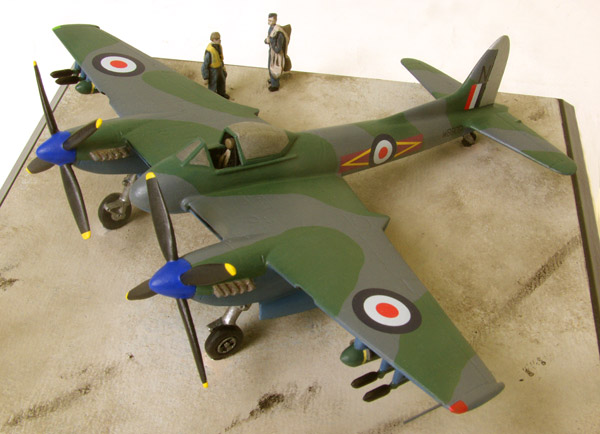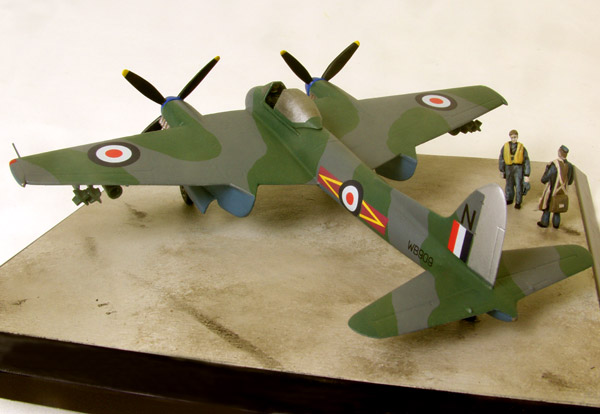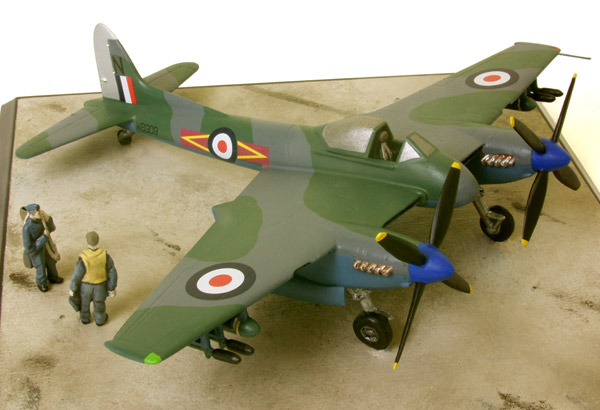de Havilland Hornet F3
de Havilland Hornet F3 WB909 N 80 Squadron,
RAF Kai Tak, Hong Kong 1954
The de Havilland Hornet is probably the best-looking piston-engined fighter to fly. The design of the de Havilland DH.103 Hornet built on the experience gained from the Mosquito, and with the probable need for a long-range fighter for use in an island-hopping war in the Pacific in mind. Specification F.12/43 was substantially drawn up around de Havilland’s early design studies and first prototype de Havilland Hornet RR915 flown on 28 July 1944; this was unarmed, but the second, de Havilland Hornet RR919, carried four 20 mm cannon. The first production order, for sixty, was placed before the end of the year and the first, PX210, flew from Hatfield on 1 February 1945.
Sixty de Havilland Hornet F Mk 1s were built at Hatfield, all this batch with the easily-recognisable “de Havilland” fin and rudder shape; eight de Havilland Hornet PR 2s, three conversions and five production aircraft followed but the proposed order for this mark was cancelled – the role was filled by PR Mosquitos – and all eight were scrapped. The main production version was the de Havilland Hornet F3; this had a larger tailplane and elevator and provision for two 200 gallon underwing tanks or a pair of 1000 lb bombs, and four Rocket Projectile rails. Shortly after this mark entered service a substantial dorsal fin was fitted without spoiling the aircraft’s graceful lines – or concealing its “de Havilland” identity – and this was also retro-fitted to earlier de Havilland Hornets, sometimes by the squadrons. The last production batch was a dozen de Havilland Hornet F4s built at Chester; this required the fitting of a vertically mounted F.52 camera in the fuselage, which necessitated a slight reduction in the size of a fuselage fuel tank, and eleven Hornet F3s were modified to this configuration by Airwork at Gatwick.
de Havilland Hornet F1s equipped four UK-based Fighter Command squadrons, 64 and 65 at Linton-on-Ouse and 19 and 41 at Church Fenton (the War Plan would have had them operating as a wing from Duxford). Their principal use appears to have been for low-level interception, the so-called “rat and terrier” role; all four were re-equipped with the later mark but by the beginning of the ‘fifties had exchanged Hornets for Meteor F4s; some of their aircraft were then transferred to the Far East Air Force to help equip three squadrons, 33 and 45 in Malaya and 80 in Hong Kong but this programme was largely filled by new-build aircraft.
Although the first sixty de Havilland Hornets were built at Hatfield production was then transferred to Chester, which was responsible for sixty-nine de Havilland Hornet F3s/F4s. WB909 was delivered to 10 MU in July 1951; by the end of the year it was with 80 Squadron at Kai Tak. As well as N, it was coded W, F and L during its service with the unit, and suffered at least two mishaps; in April 1952 its propellers hit the sea during an attack exercise on the carrier HMS Ocean, and in the following October its canopy shattered and caused some airframe damage. It was struck off charge coincident with the disbandment of the squadron in May 1955.
de Havilland Hornets in FEAF were both “silver” and camouflaged, and when they arrived on 80 Squadron they carried on the W2 codes from the Spitfire era. Although there had been some thoughts on “fighter bars” in 1951, they were agreed and applied in 1953 in the form of a maroon rectangle – a very unusual colour for that purpose in the RAF – with a broad yellow/gold chevron. The larger underwing fuel tanks were frequently worn, with a pair of rocket projectile rails fitted outboard of the tanks; the squadron’s primary role was that of ground attack and reconnaissance, with the secondary task of interception.
80 Squadron RFC was formed at Montrose, Scotland in August 1917, and by the following January was at Beverley, Yorkshire equipped with the Sopwith Camel and awaiting a move to France. Its commanding officer was Major V Douglas Bell, whose name was to provide the inspiration for the unit’s crest that survived until the final disbandment in 1969. Moving with the progress of the war, at the end of hostilities it was based at Charleroi, but in early 1919 moved to Aboukir in Egypt, flying the Sopwith Snipe. It was re-numbered 56 Squadron in February 1920. Its next phase of existence started in March 1937, when it was re-formed from a nucleus of “B” Flight of 17 Squadron at Kenley flying the Gloster Gauntlet, moving a week later to Henlow, and receiving Gloster Gladiator Is; on 28 March a new arrival was Fg.Off.M St J Pattle, who become celebrated with the squadron in the Near East in WW II and is widely believed to have been the RAF’s top-scoring fighter pilot of the conflict. After moving to Debden in June 1937, a much greater upheaval took place in mid-1938 when the squadron, enlarged in both personnel and material, returned to Egypt, this time to Ismalia. With the outbreak of war the squadron, initially part of the defence of Egypt, then became involved in the Western Desert fighting before being sent to Greece in November 1940 as the basis of the fighter component of the RAF’s expeditionary force, returning to Palestine in March 1941. The Gladiators were supplemented with Hurricanes, which then became the squadron’s sole equipment for its period around the Canal Zone, moving on to Spitfire Mk Vs and then Mk IXs before being brought back to England in May 1944; quickly equipped with the Tempest Mk V, the squadron spent a short while at Manston on anti-V1 patrol before moving to Europe as part of 2nd Tactical Air Force until the end of hostilities. Remaining in Germany, principally at Wunsdorf, the squadron moved to Gutersloh with Spitfire F 24s in January 1948, and a year later took this type to Hong Kong. The Hornets (and a Mosquito) came at the end of 1951, but the squadron disbanded in May 1955; reformed with the Canberra PR.7 at Laarbruch in August it moved to Bruggen in June 1957, but was disbanded for the last time at Bruggen in September 1969.
Not only did the de Havilland Hornet look the part – it was one of those aircraft that looked as though it was at speed even when chocked at dispersal – but by all accounts it flew the part; Captain Eric Brown, a pilot with a wider experience of different aircraft of the ‘forties and ‘fifties than anyone, described the Sea Hornet as “the Grand Prix car of the air”. With surges of power available he described vertical manoeuvres as “like being in a zooming rocket” and aerobatics as “sheer exhilarating joy”! Its wooden structure brought its service in the Far East to an early end, and sadly there is no de Havilland Hornet left today to look at on the ground, let alone in the air.
Scale 1:72 Wingspan 7.62″ (190.5 mm)
Base size 7.71″ (196 mm) square (No. 5)
Weight not including base 14.75 ozs (421 grams) Limited edition of 25 only
SOLD OUT




